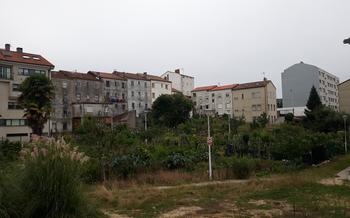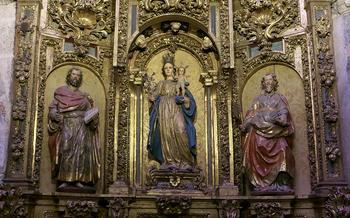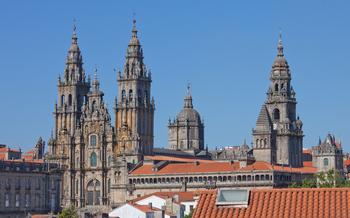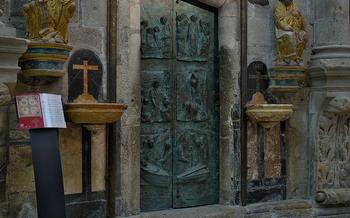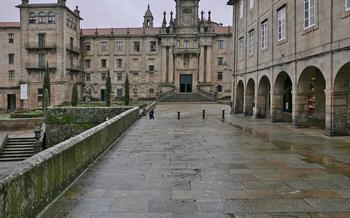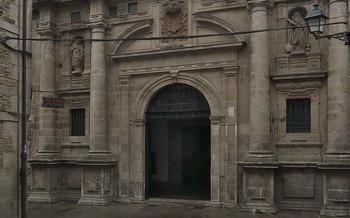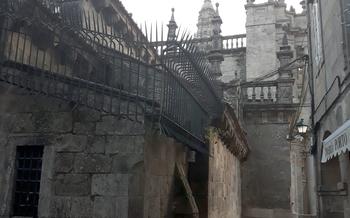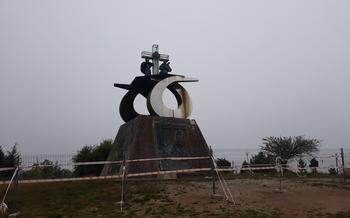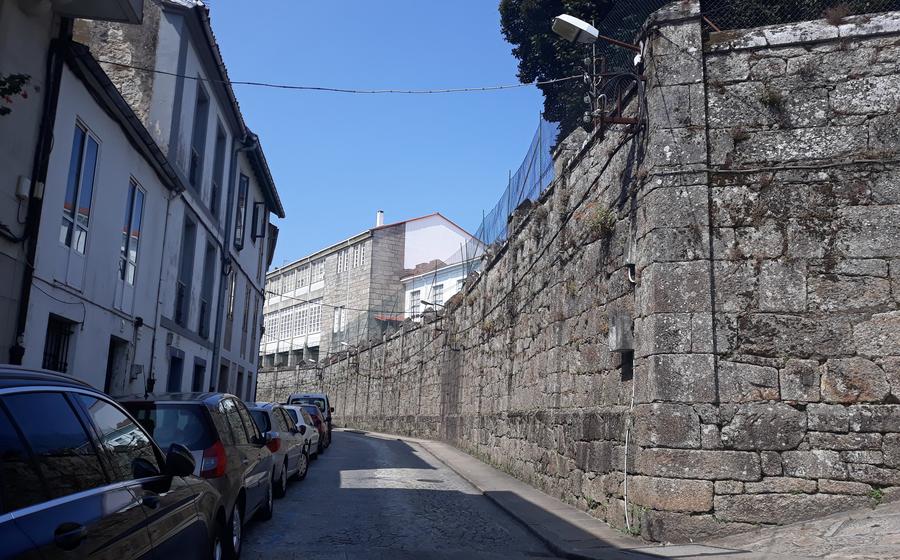
Church of San Bieito do Campo Romanesque church
- Atop the Hill of San Marcos
- Exploring the Majestic Façade
- Stepping into the Serene Interior
- Discovering the Romanesque Frescoes
- Unveiling the Royal Pantheon
- Exploring the Adjoining Monastery
- Unraveling the Legend of the Burning Rose: A Symbol of Divine Guidance
- Witnessing the grandeur of the Portico de la Gloria
- Marveling at the Tower of San Bieito: A Sentinel Overlooking Santiago
- Exploring the Surrounding Area
- Capturing the Perfect Photo
- Learning about the History of Santiago de Compostela:
- Insider Tip: Unveiling Hidden Gems and Local Traditions
Atop the Hill of San Marcos
Perched atop the Hill of San Marcos, the Church of San Bieito do Campo stands as a testament to the architectural prowess and spiritual devotion that shaped medieval Europe. Constructed in the 12th century, this Romanesque masterpiece captivates visitors with its serene beauty and historical significance. From its hilltop vantage point, the church commands breathtaking views of the surrounding countryside, a tapestry of verdant hills and winding rivers that stretch as far as the eye can see.
Over the centuries, the church has undergone various modifications, evolving from its original Romanesque style to incorporate Baroque elements. This architectural transformation reflects the changing artistic sensibilities and tastes of successive eras, showcasing the enduring legacy of San Bieito do Campo. The church's remarkable preservation has earned it the distinction of being declared a National Monument and inscribed on the prestigious UNESCO World Heritage List, solidifying its status as a cultural treasure of global significance.
Exploring the Majestic Façade
The Church of San Bieito do Campo boasts a captivating façade that serves as a testament to the intricate artistry of the Romanesque period. The main entrance, with its recessed arch, draws the eye with its central rose window, an exquisite example of medieval craftsmanship. The rose window is adorned with intricate carvings depicting scenes from the life of Christ and the saints, inviting visitors to delve into the rich symbolism and iconography of the church.
The portal's design seamlessly blends Romanesque and Gothic elements, showcasing the transition between architectural styles. The graceful pointed arches and slender columns hint at the Gothic influence, while the rounded arches and robust construction speak to the church's Romanesque roots. The weathering of the façade over time has added a layer of charm and authenticity, giving the church a sense of timeless beauty.
Standing before this majestic façade, one can't help but admire the skill and devotion of the medieval artisans who painstakingly created this architectural masterpiece. The interplay of light and shadow across the weathered stone surfaces adds to the church's allure, inviting visitors to step inside and explore the treasures that lie within.
Stepping into the Serene Interior
The interior of the Church of San Bieito do Campo exudes an atmosphere of serenity and grace. Its simple and harmonious proportions create a sense of spaciousness, inviting visitors to contemplate the architectural beauty within. The barrel-vaulted ceiling, supported by sturdy columns, rises majestically above the nave, contributing to the feeling of grandeur.
The interplay of light and shadow through the stained-glass windows casts a warm and ethereal glow upon the sacred space. The windows, with their vibrant colors and intricate designs, depict scenes from the Bible and the lives of the saints, adding to the church's spiritual ambiance.
Despite its historical significance and architectural grandeur, the interior of the Church of San Bieito do Campo is remarkably devoid of excessive ornamentation. This restraint allows the architectural features to take center stage, creating a serene and contemplative environment conducive to prayer and reflection.
Discovering the Romanesque Frescoes
The Church of San Bieito do Campo is home to a series of well-preserved Romanesque frescoes that offer a glimpse into the artistic and religious practices of the medieval period. These vibrant and expressive paintings adorn the walls of the church, depicting biblical narratives and religious figures with remarkable detail and emotion. The frescoes were created using a technique known as "al fresco," where pigments are applied directly onto wet plaster, resulting in a durable and long-lasting artwork.
The most notable frescoes are located in the apse of the church, where they depict scenes from the life of Christ, including the Annunciation, the Nativity, and the Crucifixion. The figures are rendered with a sense of realism and humanity, conveying a deep emotional connection between the viewer and the sacred stories. The colors used in the frescoes are still remarkably vivid, despite the passage of time, and contribute to the overall sense of awe and inspiration within the church.
In recent years, extensive restoration efforts have been undertaken to preserve these valuable artworks for future generations. The frescoes have been carefully cleaned and restored, revealing their original beauty and intricate details. These efforts have ensured that the legacy of the Romanesque frescoes at the Church of San Bieito do Campo will continue to inspire and captivate visitors for centuries to come.
Unveiling the Royal Pantheon
The Church of San Bieito do Campo is home to a remarkable royal pantheon, a testament to the power and prestige of the Galician monarchy. Built by King Alfonso VII in the 12th century, the pantheon served as the burial ground for Galician royalty, housing the remains of kings, queens, and other members of the royal family.
The royal pantheon is an architectural masterpiece, showcasing a blend of Romanesque and Gothic elements. Its vaulted ceilings, intricate carvings, and elegant stained-glass windows create a solemn and awe-inspiring atmosphere. The elaborate tombs and sarcophagi of the kings and queens are adorned with intricate carvings and inscriptions, each telling a story of power, lineage, and devotion.
Among the notable figures buried in the pantheon are King Alfonso VII, the founder of the pantheon, and his wife, Queen Berenguela of Barcelona. Their tombs are particularly elaborate, featuring life-size effigies of the royal couple and intricate carvings depicting scenes from their lives and reigns.
The royal pantheon is a significant reminder of the rich history of Santiago de Compostela and the important role played by the Galician monarchy in shaping the city's development. It offers visitors a glimpse into the lives and legacies of the rulers who once governed this region, adding to the church's historical and cultural significance.
Exploring the Adjoining Monastery
The Church of San Bieito do Campo is not just a remarkable architectural masterpiece; it is also part of a larger monastic complex with a rich history. Founded in the 9th century by Benedictine monks, the adjoining monastery played a pivotal role in the development of Santiago de Compostela as a religious and cultural center.
Over the centuries, the monastery underwent several expansions and renovations, incorporating various architectural styles, from Romanesque to Gothic and Renaissance. The result is a harmonious blend of architectural elements that showcases the evolution of monastic architecture in Galicia.
The heart of the monastery is the cloister, a serene and contemplative space surrounded by arched walkways and galleries. The cloister served as a place of meditation, study, and work for the monks, providing a tranquil retreat from the bustling world outside.
Today, the monastery is no longer inhabited by monks, but it remains a heritage site of great importance. Visitors can explore the cloister, admire its architectural details, and immerse themselves in the peaceful atmosphere that has permeated these walls for centuries. Ongoing preservation efforts ensure that this historic monument continues to stand as a testament to the enduring legacy of the Benedictine order in Santiago de Compostela.
Unraveling the Legend of the Burning Rose: A Symbol of Divine Guidance
Legends and folklore often intertwine with history, shaping the cultural tapestry of a place. The Church of San Bieito do Campo is no exception, as it holds a captivating legend that has endured for centuries: the legend of the burning rose.
According to local lore, the founding of the monastery was guided by a miraculous event. In the 9th century, a group of Benedictine monks embarked on a journey to establish a new monastery in Galicia. As they wandered through the dense forests, they encountered a mysterious burning rose floating in the air. Intrigued and inspired, they followed the rose, believing it to be a sign from above.
The monks' journey led them to a hilltop overlooking the Sar River, where they discovered a suitable location for their monastery. They interpreted the burning rose as a symbol of divine guidance and protection, and thus, the monastery was founded on that very spot.
The legend of the burning rose has become an integral part of the church's history and identity. It is often depicted in the church's iconography, including sculptures and stained-glass windows, serving as a reminder of the divine intervention that led to the monastery's establishment.
The enduring popularity of the legend speaks to its symbolic power and its resonance with the local community. The burning rose has become a symbol of hope, faith, and divine guidance, inspiring pilgrims and visitors alike who come to explore this sacred site.
Witnessing the grandeur of the Portico de la Gloria
At the western entrance of the Church of San Bieito do Campo, visitors are awestruck by the Portico de la Gloria, a masterpiece of Romanesque sculpture that narrates the Last Judgment through intricate carvings. Christ sits enthroned in majesty, surrounded by apostles, angels, and the twenty-four elders of the Apocalypse. The portico's design harmoniously blends Romanesque and Gothic elements, showcasing the transition between artistic styles. The vivid depiction of the heavenly court, with its expressive figures and meticulous attention to detail, leaves an indelible impression on the viewer.
Extensive restoration efforts have been meticulously carried out to preserve this iconic work of art, ensuring its longevity and allowing visitors to appreciate its grandeur fully. The Portico de la Gloria stands as a testament to the artistic brilliance of the Romanesque era and is a must-see for anyone visiting the Church of San Bieito do Campo.
Marveling at the Tower of San Bieito: A Sentinel Overlooking Santiago
Standing tall and proud next to the Church of San Bieito do Campo is the Tower of San Bieito, a testament to the rich history and architectural heritage of Santiago de Compostela. Built in the 12th century, this imposing tower served as a defensive structure, protecting the monastery from attacks and safeguarding the treasures within its walls.
Adorned with narrow windows and impressive battlements, the tower exudes an air of strength and resilience. Its sturdy construction has withstood the test of time, ensuring its survival through centuries of change and upheaval. Today, the tower serves a different purpose, guiding visitors with its melodious bells that ring out across the city, marking the passage of time and inviting pilgrims and tourists alike to explore its wonders.
Ascending the tower's winding staircase rewards visitors with breathtaking panoramic views of Santiago de Compostela and the surrounding countryside. From this elevated vantage point, one can admire the intricate details of the church's architecture, the lush greenery of the surrounding hills, and the vibrant cityscape that stretches out in all directions. The Tower of San Bieito stands as a silent sentinel, watching over the city and its inhabitants, a symbol of enduring strength and resilience.
Exploring the Surrounding Area
Beyond the walls of the Church of San Bieito do Campo lies a tapestry of natural and cultural treasures waiting to be discovered. Take a leisurely stroll along the banks of the Sar River, just a stone's throw from the church, and immerse yourself in the tranquility of the flowing waters and the lush greenery that lines its banks. Explore the picturesque parks and gardens nearby, offering respites of serenity amidst the urban bustle. Discover hidden gems and off-the-beaten-path attractions in the surrounding neighborhood, such as charming cafes tucked away in narrow cobblestone streets or vibrant markets showcasing local produce and artisanal crafts. Indulge in the culinary delights of Santiago de Compostela by sampling traditional Galician cuisine at local restaurants, savoring the flavors of freshly caught seafood, succulent meats, and delectable pastries. The area surrounding the Church of San Bieito do Campo is a treasure trove of experiences, inviting you to delve deeper into the cultural and natural heritage of this captivating city.
Capturing the Perfect Photo
The Church of San Bieito do Campo offers a wealth of photo opportunities for capturing its architectural grandeur and serene atmosphere. To capture the best shots, consider the following tips:
-
Seek the Golden Hour: Plan your visit during the golden hour, the magical period around sunrise or sunset when the warm, diffused light casts a golden glow on the church's exterior, enhancing its intricate details.
-
Experiment with Angles: Don't limit yourself to straightforward shots. Experiment with different angles to create dynamic compositions. Try capturing the church from below to emphasize its height, or shoot from a distance to capture its picturesque setting amidst the surrounding countryside.
-
Focus on Details: The church's exterior is adorned with intricate carvings and sculptures. Take your time to zoom in and capture the fine details of these decorative elements, which often go unnoticed by the casual observer.
-
Explore the Interior: The church's interior offers a different set of photographic opportunities. Capture the harmonious proportions of the nave, the graceful arches, and the delicate stained-glass windows. Don't forget to look up to capture the intricate details of the barrel-vaulted ceiling.
-
Share Your Masterpieces: Once you've captured your perfect shots, share them with the world on social media to inspire others to visit this architectural gem. Use hashtags like #ChurchofSanBieito, #RomanesqueArchitecture, and #SantiagoDeCompostela to reach a wider audience.
Learning about the History of Santiago de Compostela:
Santiago de Compostela is a city steeped in history and religious significance. Its origins can be traced back to the discovery of the tomb of St. James the Great, one of Jesus's twelve apostles, in the 9th century. This discovery led to the establishment of the city as a major pilgrimage destination, and the Camino de Santiago, a network of pilgrimage routes, was developed to guide pilgrims to the city.
Over the centuries, Santiago de Compostela has grown into a vibrant and cosmopolitan city, while retaining its deep-rooted religious traditions. The city's rich history is reflected in its architecture, with buildings ranging from Romanesque churches to Baroque palaces. The Cathedral of Santiago, a UNESCO World Heritage Site, is the city's most iconic landmark and a must-visit for any visitor.
Exploring the history of Santiago de Compostela is an enriching experience that allows visitors to delve into the city's religious and cultural heritage. By visiting historic landmarks, such as the Cathedral, the Plaza del Obradoiro, and the Museum of the Pilgrimages of Santiago de Compostela, visitors can gain a deeper understanding of the city's past and its enduring significance as a pilgrimage destination.
Insider Tip: Unveiling Hidden Gems and Local Traditions
Beyond the main attractions of the Church of San Bieito do Campo, there are hidden gems and local traditions waiting to be discovered. One such gem is the small chapel dedicated to San Bieito, located within the church. This intimate space features a beautiful altarpiece and exudes a serene atmosphere, inviting visitors to pause and reflect.
For those seeking a deeper understanding of the Camino de Santiago, a visit to the nearby Museum of the Pilgrimages of Santiago de Compostela is a must. This museum showcases the history and cultural significance of the pilgrimage, offering insights into the motivations and experiences of pilgrims throughout the centuries.
To immerse yourself in a truly unique Galician tradition, participate in the queimada ceremony. This ritual involves the preparation and drinking of queimada, a flaming alcoholic beverage, accompanied by incantations and spells. Performed in a convivial atmosphere, the queimada ceremony is a captivating spectacle that offers a glimpse into the rich cultural heritage of Galicia.
